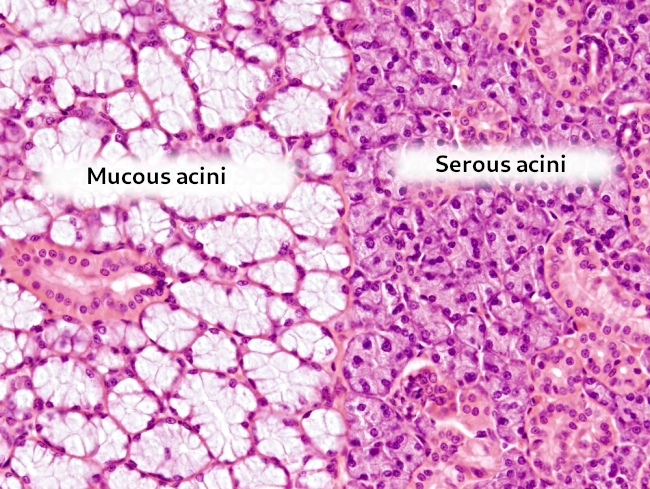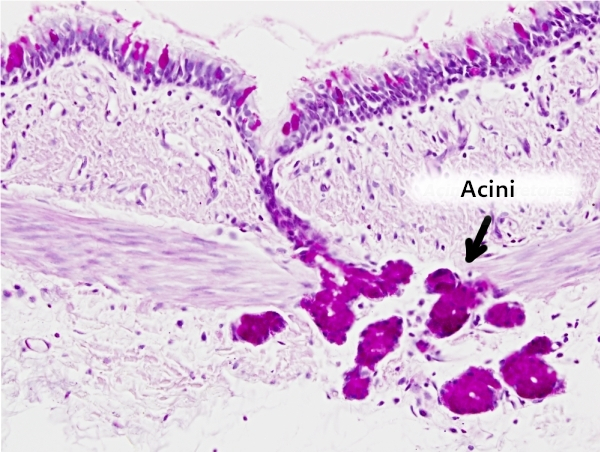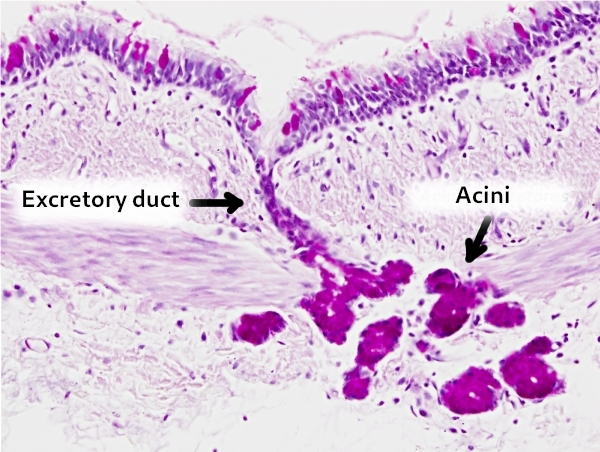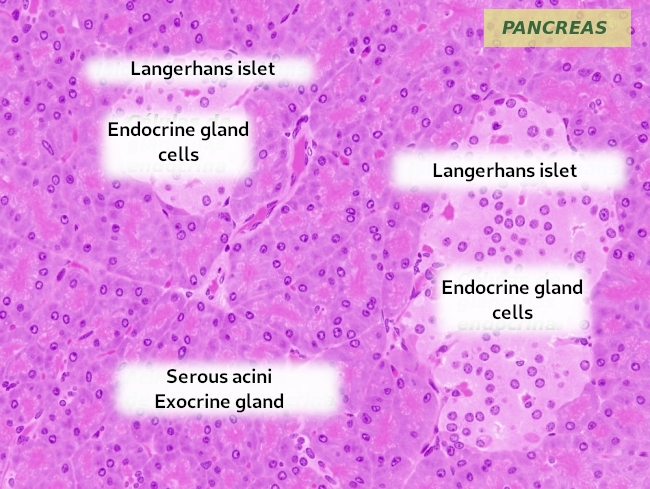|
These are the answers to the quiz.
|
1) Epithelial cells are separated from one another by large amounts of extracellular matrix.
|
| Not answered. It is false. Epithelial tissues have very little extracellular matrix. Epithelial cells tightly adhere to each other by cell-cell adhesion junctions and do not have much extracellular space. |
2) The epithelial tissue is highly irrigated by blood vessels.
|
| Not answered. It is false. Epithelial tissues do not have blood vessels. Nutrients and oxygen diffuse from blood vessels running through the underlying connective tissue. |
3) The mesothelium is a type of epithelium.
|
| Not answered. It is true. Mesothelium is a type of epithelium delimiting the inner body cavities, such as the heart, lungs, and abdominal cavities. |
4) The endothelium is simple squamous epithelium.
|
| Not answered. It is true. The endothelium is a simple squamous epithelium lining the inner surface of blood and lymphatic vessels. |
5) The stratum granulosum is observed in the stratified cuboidal epithelia.
|
| Not answered. It is false. The stratum granulosum can be observed in the keratinized squamous stratified epithelium. It is formed by maturation of epithelial cells that later form the stratum corneum, which is the outermost stratum. |
6) Between epithelia and the underlying connective tissue, there is a thin layer of extracellular matrix known as basal lamina.
|
| Not answered. It is true. The basal lamina is found in the basal domain of all epithelia. It is a layer of highly organized extracellular matrix with abundant type IV collagen. |
7) Simple cuboidal epithelium is found in the excretory ducts of some exocrine glands.
|
| Not answered. It is true. Simple cuboidal epithelium can be found in the excretory ducts of glands, such as the salivary glands. This type of epithelium is also found in other tubules, for instance, the proximal and distal tubules of the kidney. |
8) In the basal domain of some epithelia, such as the simple cuboidal and pseudostratified epithelia, there are cell specializations like microvilli and cilia.
|
| Not answered. It is false. Simple cuboidal and pseudostratified epithelia show specializations in the apical domain, but not in the basal domain. These cellular specializations may be microvilli, cilia, and stereocilia. For example, the intestinal epithelium shows microvilli on its apical surface (the free surface). |
9) Intraepithelial glands may be found as isolated cells or associated in small groups.
|
| Not answered. It is true. Intraepithelial glandular cells are found between non-secretory epithelial cells, either isolated or in small groups. |
10) Endocrine glands show excretory ducts.
|
| Not answered. It is false. Endocrine glands have no excretory ducts. The products are released to the surrounding extracellular space. From here they diffuse and enter the blood vessels to be delivered to other parts of the body. |
|
11) Epithelial cells are attached to one another largely through cell junctions.
|
| Not answered. It is true. Since there is not much extracellular matrix in the epithelium, epithelial cells adhere to each other through direct cell-cell adhesion contacts, such as desmosomes, tight junctions, and adherent junctions. |
12) Stratified cuboidal epithelia show a stratum corneum.
|
| Not answered. It is false. Only stratified squamous epithelia show a stratum corneum. The stratum corneum is the result of the epidermal cells that die to form the outer impermeable layer of the skin. |
13) The epidermis, endothelium, and mesothelium are stratified squamous epithelium.
|
| Not answered. It is false. The epidermis is keratinized stratified squamous epithelium. Endothelium and mesothelium are simple squamous epithelium. |
14) More than one cell type may be found in the epithelia.
|
| Not answered. It is true. For instance, keratinocytes, melanocytes, and Merkel cells are found in the epidermis. Even more cell diversity is found in the intestinal epithelium. |
15) We smell thanks to an epithelium.
|
| Not asnwered. It is true. There are specialized epithelia that perform very specific functions. In the nasal cavity, the olfactory epithelium allows us to perceive airborne substances. Olfactory epithelium is a pseudostratified epithelium. |
16) The endothelium is glandular epithelium.
|
| Not answered. It is false. The endothelium is a type of covering epithelium. It is lining the inner surface of blood vessels. Other covering epithelia are epidermis, respiratory epithelium, most of the intestinal epithelium, and mesothelium. |
17) A simple epithelium contains cells without a nucleus.
|
| Not answered. It is false. A simple epithelium is made up of one cell layer in thickness, but all cells contain a nucleus. |
18) The cells of pseudostratified epithelia show nuclei located at different heights from the basal ganglia, but all cells are in contact with the basal lamina.
|
| Not answered. It is true. |
19) Simple epithelium may be keratinized.
|
| Not answered. It is false. Keratinized epithelia are the epidermis, the esophagus in some species, and the vaginal epithelium. All of them are stratified squamous epithelia. Simple epithelium is not keratinized. |
20) The basal lamina is found only below stratified epithelium because it has to support more cell layers.
|
| Not answered. It is false. The basal lamina is found below every epithelium, separating the epithelial cells and the connective tissue. |
|
21) The endothelium is a simple squamous epithelium.
|
| Not answered. It is true. The endothelium is lining the interior of blood and lymphatic vessels. |
22) The stratum spinosum can be observed in the stratified cuboidal epithelium.
|
| not answered. It is false. The stratum spinosum can be observed in the stratified squamous epithelia, in both keratinized and non-keratinized. |
23) Melanocytes are found in the basal layer of the columnar stratified epithelium.
|
| Not answered. It is false. Melanocytes are found in the epidermis, which is keratinized stratified squamous epithelium. |
24) Besides the epidermis, keratinized stratified squamous epithelium can be found in other places.
|
| Not answered. It is true. Keratinized stratified squamous epithelium can be found in the upper part of the esophagus and in the tongue of animals that eat hard food. |
25) Stratified squamous epithelium can be found in the esophagus.
|
| Not answered. It is true. It is also found in the vagina, the oral cavity, and the cornea. Normally, the stratified squamous epithelium is a tissue hydrated by glandular secretions. |
26) Simple cuboidal epithelium can be found lining the interior of the blood vessels.
|
| Not answered. It is false. The simple cuboidal epithelium is found in glandular excretory ducts, in the pigmented epithelium of the retina, and in the convoluted ducts of the kidney (and in other places). The blood vessels are lined by simple squamous epithelium. |
27) Stratified cuboidal epithelium is usually made up of many layers of cells.
|
| Not answered. It is false. Normally, there are two or three layers of cells in the stratified cuboidal epithelium, which is found in the excretory ducts of some glands. |
28) Simple columnar epithelium shows apical specializations like cilia and microvilli.
|
| Not answered. It is true. It is frequent to observe cilia in the simple columnar epithelium of the uterine ducts and microvilli in the intestinal epithelium. |
29) Transitional epithelium is specialized in filtering.
|
| Not answered. It is false. Since the transitional epithelium recovers its resting shape after stretching, it is suitable to line cavities that often change volume, like the gallbladder and urinary ducts. |
30) Pseudostratified epithelium contains a layer of cells with cuboidal and squamous morphology. That is why the name is pseudostratified.
|
| Not answered. It is false. The name pseudostratified is because there are nuclei at different heights in the epithelium, and therefore it looks like it is stratified. However, all cells are in contact with the basal lamina. |
|
31) Glands are made up of cells derived from the connective tissue.
|
| Not answered. It is false. Grandular cells are derived from embryonic epithelial tissues. |
32) Exocrine glands release their content to the exterior of the body.
|
| Not answered. It is true. Exocrine glands release their content to the skin, digestive tract, and respiratory tract. |
33) During merocrine secretion, part of the cytoplasmic content is also released by the cell.
|
| Not amswered. It is false. Release of part of the cytoplasm content happens during apocrine secretion. During merocrine secretion, only the vesicle content is released. On the other hand, holocrine secretion leads to the release of the complete cellular content. |
34) A mixed salivary gland releases serous and mucous substances at the same time.
|
| Not answered. It is true. They have acini with either mucous or serous cells, and some acini with both types of secretory cells. |
35) Endocrine glands do not have excretory ducts.
|
| Not answered. It is true. Endocrine glands release their content to the extracellular space, and substances reach blood vessels by diffusion. |
36) The adrenal gland is an endocrine gland.
|
| Not answered. It is true. The adrenal gland is an endocrine gland found overlying the upper part of the kidneys. Other endocrine glands are the hypophysis and pancreas (but only the Langerhans islets). |
Click on the images to enlarge. |
F-1) The region delimited by the dashed line is known as stratum granulosum.

|
Not answered. It is false. The dashed line encloses the stratum spinosum.
 |
F-2) The arrows point to the basal lamina.

|
Not answered. It is true. The basal lamina separates the connective tissue from the basal domain of epithelia.
 |
F-3) This is a simple squamous epithelium.

|
Not answered. It's untrue. Because it consists of a single layer of cells that are higher than wide, it is a simple columnar epithelium.
 |
F-4) Arrows point to the basal domain of the epithelium.

|
Not answered. It is false. The apical domain of epithelia is facing the inner cavities or outer space, whereas the basal domain faces the connective tissue.
 |
F-5) Asterisks indicate mucous acini.

|
Not answered. It is true. Mucous acini contain many mucopolysaccharides that are not well-stained with common dyes. So, cells are not stained and appear in white. Serous acini, on the other hand, contain many proteins and are stained in purple by basic dyes like hematoxylin (for instance, in this image).
 |
F-6) This is an endocrine gland.

|
Not answered. It is false. It is an exocrine gland because there is an excretory duct that releases the content outside the organism. Notice that it is a compound exocrine gland.
 |
F-7) Asterisks indicate the acini of an exocrine gland.

|
Not answered. It is false. Asterisks indicate the endocrine part of the pancreas, that is, the Langerhans islets. The rest of the tissue is made up of serous acini that form the exocrine part of the pancreas, which releases its content into the digestive duct.
 |













